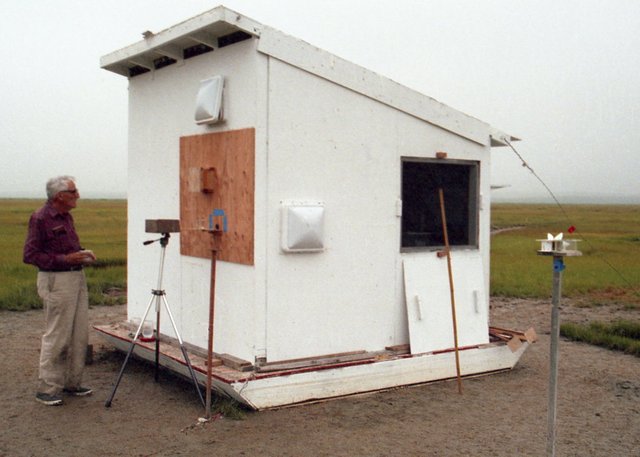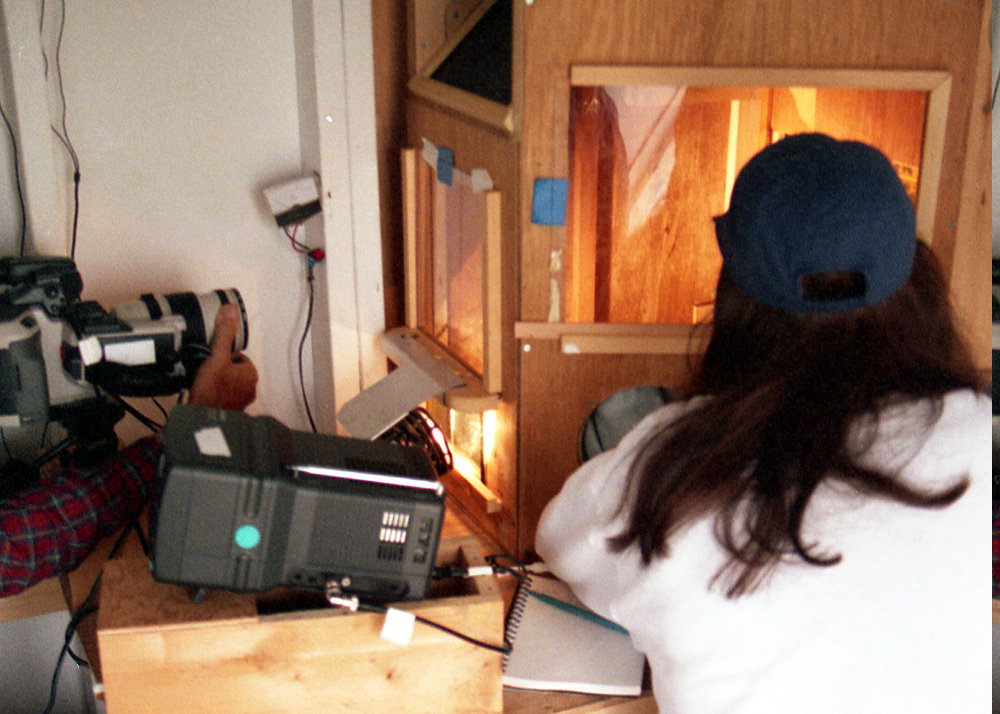What Do Animals Know, and Why Do Honeybees Dance
We have so many different ways of finding our way in this world. Magnetic compasses, maps, street signs, GPS, smart-phone apps. And it seems like each advance makes the world a little smaller.
Would you believe me if I told you that the humble, hard-working honey-bee finds its way around with a dance?
Back in high school, I had just about the best summer job anyone could get. I got to work with a world-reknowned biologist as he tried to puzzle out a puzzling question: just what do bees know?
Donald Griffin had been studying animal behavior since the 1930s. He was the one who discovered that bats find their way by echolocation. Later, he coined the term cognitive ethology to study the influence of conscious awareness on animal behavior, and argued that laboratory conditions were not appropriate for understanding how animals reacted to stimuli. These were ground-breaking ideas when he proposed them in the 1960s.

He was in his late 70s when I got to work with him. He'd decided he wanted to come to Cape Cod to study honeybee dance communication, and he'd found just the right place to do it: the salt marshes behind Sandy Neck.
The German scientist Karl von Frisch had already determined before World War Two that honeybees communicated the location of a good source of nectar (flowers!) to the rest of the hive by performing a waggle dance to other workers. The bees move in a figure-eight pattern, waggling back and forth in the middle. The duration of their waggle indicates the distance to the food source. And the direction they face during this waggle points the heading towards the food. But here's the remarkable thing - hives are oriented vertically, so they can't point directly to the food. Instead, they translate dancing "up" to mean "fly directly towards the sun," and any angle from the vertical to mean that many degrees away from the sun. The Smithsonian has a good video demonstrating this behavior:
Griffin had become fascinated with the behavior of the honeybee, and wanted to know something more: just what were these bees thinking? What made this especially interesting was the fact that a hive of bees could be considered to be, in many ways, a single organism. All the worker bees - the ones out gathering honey - were genetically identical, and female. The queen was female too, obviously, and the only female in the hive capable of reproducing. Once in her life the queen would make a nupital flight and mate with several drones. A lucky drone would load her up with enough sperm to fertilize an entire hive of eggs, and she'd spend the rest of her life depositing these eggs into the cells in the honeycomb that weren't used for storing honey.
It would seem that the queen had all the power, but this wasn't really the case. When the population of the hive grew to a certain level, or when it became clear that there weren't enough resources (flowers!) in the neighborhood to support the hive, the workers would stage a little coup. They'd start feeding some of the other eggs a special royal jelly they could excrete on their own. The hormones in this jelly would transform those eggs into new queens, which would spontaneously emerge, much bigger than regular workers, and then depart, taking half of the hive with them.
If you've ever seen a swarm of bees traveling in tight formation, or hanging in a clump from a tree branch, you're witnessing the birth of a new hive. Which, it could be argued, is more like the birth of a new individual.
If bees really thought, Griffin wondered, if they were conscious like any other animal, were they conscious on the level of the individual bee or as a collective hive?
Although to be honest, we didn't really talk about this much at all. The summer was short, and Dr. Griffin was more interested in gathering as much data as we could.

And that's why he set up a bee hive in the middle of a salt marsh. Here's the thing about a salt marsh: flowers don't grow there. Just grass. Grass is wind-pollinated, and doesn't require insects. That means that any food the bees encountered in the marsh, we put there. So that's why we built a little cottage, put it on a float, and waited for a new-moon tide when we could tow it out into the middle of the marsh and stick a hive of bees inside.
I spent my summer putting food in artificial bee-feeders painted in colors only visible in infra-red. When the bees would land and feed we'd glue numbers to their backs, then retreat back to the hive to watch them dance. I'd run a video camera while the professor held a microphone close to the back of the dancing bee to capture the audio stream - no one had really analyzed the sound before to see if it contained any meaningful information. He built a special "glove box" around an observation hive so that a microphone could be held close to the bee.
We ran experiments to see if bees could extrapolate. If the food started moving, several meters an hour, say, would the content of their dance indicate a moving target? Would they tell their hive-mates the food was likely to be farther away by the time they got out on the field? What if we changed the angle from the hive? The direction of the "waggle" of the bee's dance from the vertical indicated the angle relative to the sun. Surely they knew the sun moved throughout the day. What if the food source moved as well? This could occur in nature, as flowers bloom in waves as the sun moves across them. Could the bees figure this out to make the hive more efficient?
We ran experiments on the concentration of our artifical nectar. If different artificial flowers had different concentrations of sugar, would the bees dance more vigorously when they found a more concentrated source? (I learned about calculating Molarity, and wished I'd paid more attention during chemistry class. There was no Google in those days.)
We taped hours and hours of video on an expensive analog camcorder. Then, on rainy days, we'd sit in his rented house running the sounds through a bank of oscilloscopes and computers looking for patterns in the pulses the bees emitted while they waggled.

I learned a lot about research and patience over those two summers. I also learned about checking tide-tables and finding my way through winding creeks in an aluminum boat with an outboard motor. (It was a great commute.) The first summer, there was a lot of lugging of car-batteries back and forth from shore to power the equipment, but by the second year we'd installed solar panels on top of the cottage, which meant learning some basic electronics, as well.
I'm not sure if Dr. Griffin answered any large scale philosophical questions with this research. He continued to publish until he passed in 2003, and his name crops up in a lot of papers on the subject which are available on-line. Here's an interesting paper looking at a lot of the questions he was asking.
I ended up taking a detour away from formal education and never found my way back. But I've never forgotten the enthuiasm and the persistence of this remarkable professor, and his tenacity in finding a way to watch and record the smallest animal behaviors.
I have bees on my smallholding. Have to say that I find the sight of a gathering and departing swarm quite spectacular. Was good to read your report and learn a little more, and also it was the first time I'd seen the Waggle video , so thanks too for that. Upvoted and followed.
Thanks, @elaine54! What sort of hive do you have, and is it to gather honey or to fertilize your crops?
I'd love to hear more about your smallholding. The Wife and I are hoping to head to the UK sometime soon and spend as much time over there as we can.
It was for both, I'd planted a load of fruit trees. However,,, the dairy goats kept escaping and stripping the bark from ground level to about 6ft high, so then I began to pretend to myself and everyone else that I only had them for the honey... I shall begin posting tomorrow so you'll soon be able to read about the smallholding!
If I was him, I would have called my paper Beehivioural Psychology.
Ha! There was no shortage of bee puns around that place!
And if I wasn't too polite, I'd call you a Smartarse for thinking up a word like that. ;)
Thanks for sharing
great
Wow now i've learn something today that I can't wait to share with my friends at work... i'm mostly found of the dancing part ;) Thank you :)
It was really fascinating to watch, even after filming hundreds of hours of it.
It's amazing these little insects with tiny brains can exhibit such complex behaviors also!!
There's a lot amazing about them: the way they see infrared patterns on flowers that are invisible to us, the way they communicate and travel, and even the way they fly. Not to mention, isn't it weird how precisely they can build their honeycombs?
Yes exactly!
A very useful science
thank's for sharing
Thank You!
you'r welcome
What an absolutely incredible experience you got to have working with Dr. Griffin, it sounds like he was really something special. Very few of us get to have a mentor like that in our lives. You say you didn't continue with formal education, but I'm sure this man taught you much about life through your time together. I could only imagine the wisdoms he shared with you, his very special student.
It was quite flattering. The first summer I did it as volunteer work, but he actually requested I help him the second summer and personally paid me what I'd have made if I'd gotten a "regular" job for those months. When he found out I wasn't going to school he offered to write me a recommendation to Harvard, but by the time I seriously considered going back to school he'd passed on.
Wow....all that, and the computer too, he must have almost thought of you like a son, or the son he never had?
Great information. Bees are so fundamental In the ecosystems that they live in. And so interesting. I never knew they had so much communication occuring among hive members
I know - it's amazing how much of our food is completely reliant on insect pollination! Just a few species have such a big impact on everything we eat.
Key stone species. I'd definitely consider bees a key stone species!
What amazing research to have been involved with! And an awesome post you wrote about it, the video really helped to visualise your story, well done!
Thank's, @tishyaoedit! It really was an honor to work with this guy.
That's a beautifully shot video, isn't it? It's amazing how much more information is available now than when we were doing the research.